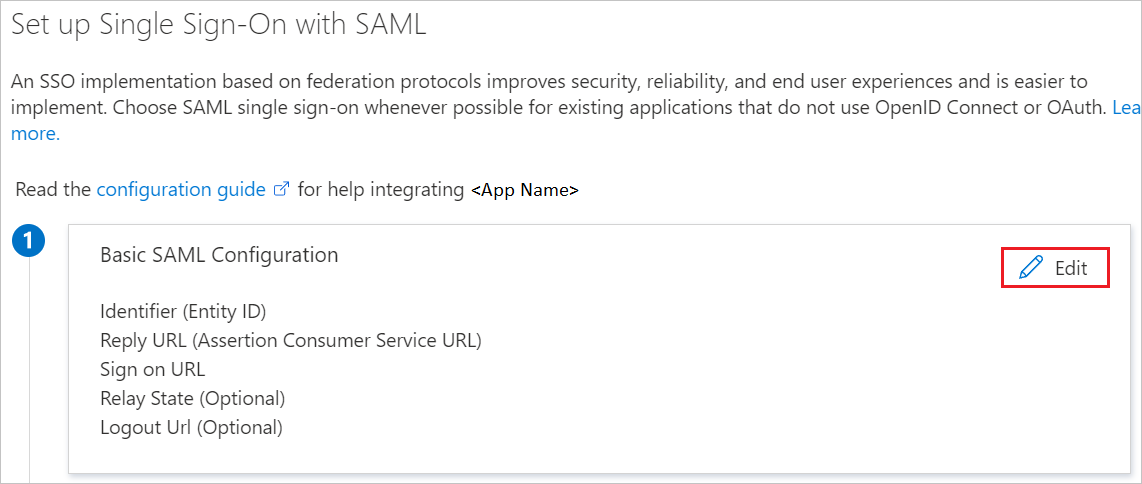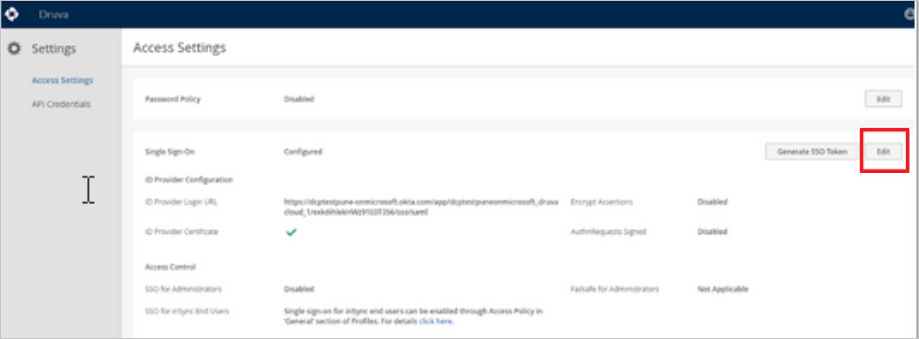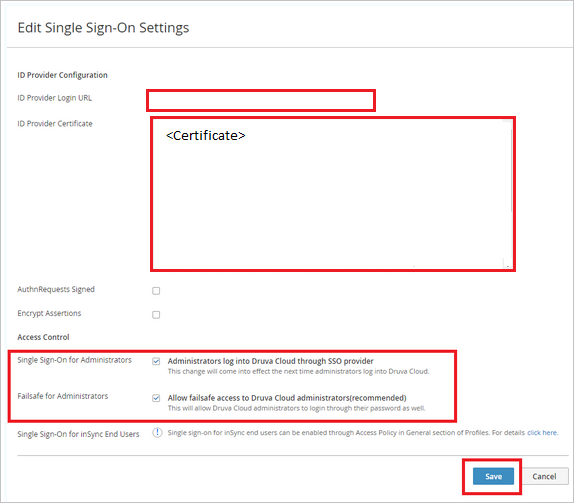Tutorial: Microsoft Entra single sign-on (SSO) integration with Druva
In this tutorial, you'll learn how to integrate Druva with Microsoft Entra ID. When you integrate Druva with Microsoft Entra ID, you can:
- Control in Microsoft Entra ID who has access to Druva.
- Enable your users to be automatically signed-in to Druva with their Microsoft Entra accounts.
- Manage your accounts in one central location.
Prerequisites
To get started, you need the following items:
- A Microsoft Entra subscription. If you don't have a subscription, you can get a free account.
- Druva single sign-on (SSO) enabled subscription.
Scenario description
In this tutorial, you configure and test Microsoft Entra SSO in a test environment.
- Druva supports IDP initiated SSO.
- Druva supports Automated user provisioning.
Note
Identifier of this application is a fixed string value so only one instance can be configured in one tenant.
Add Druva from the gallery
To configure the integration of Druva into Microsoft Entra ID, you need to add Druva from the gallery to your list of managed SaaS apps.
- Sign in to the Microsoft Entra admin center as at least a Cloud Application Administrator.
- Browse to Identity > Applications > Enterprise applications > New application.
- In the Add from the gallery section, type Druva in the search box.
- Select Druva from results panel and then add the app. Wait a few seconds while the app is added to your tenant.
Alternatively, you can also use the Enterprise App Configuration Wizard. In this wizard, you can add an application to your tenant, add users/groups to the app, assign roles, as well as walk through the SSO configuration as well. Learn more about Microsoft 365 wizards.
Configure and test Microsoft Entra SSO for Druva
Configure and test Microsoft Entra SSO with Druva using a test user called B.Simon. For SSO to work, you need to establish a link relationship between a Microsoft Entra user and the related user in Druva.
To configure and test Microsoft Entra SSO with Druva, perform the following steps:
- Configure Microsoft Entra SSO - to enable your users to use this feature.
- Create a Microsoft Entra test user - to test Microsoft Entra single sign-on with B.Simon.
- Assign the Microsoft Entra test user - to enable B.Simon to use Microsoft Entra single sign-on.
- Configure Druva SSO - to configure the single sign-on settings on application side.
- Create Druva test user - to have a counterpart of B.Simon in Druva that is linked to the Microsoft Entra representation of user.
- Test SSO - to verify whether the configuration works.
Configure Microsoft Entra SSO
Follow these steps to enable Microsoft Entra SSO.
Sign in to the Microsoft Entra admin center as at least a Cloud Application Administrator.
Browse to Identity > Applications > Enterprise applications > Druva > Single sign-on.
On the Select a single sign-on method page, select SAML.
On the Set up single sign-on with SAML page, click the pencil icon for Basic SAML Configuration to edit the settings.

On the Basic SAML Configuration section, perform the following steps:
a. In the Identifier (Entity ID) text box, type the string value:
DCP-login.b. In the Reply URL (Assertion Consumer Service URL) text box, type the URL:
https://cloud.druva.com/wrsaml/consume.Click Save.
Druva application expects the SAML assertions in a specific format, which requires you to add custom attribute mappings to your SAML token attributes configuration. The following screenshot shows the list of default attributes.

In addition to above, Druva application expects few more attributes to be passed back in SAML response which are shown below. These attributes are also pre populated but you can review them as per your requirements.
Name Source Attribute emailAddress user.email druva_auth_token SSO Token generated from DCP Admin Console, without quotation marks. For example: X-XXXXX-XXXX-S-A-M-P-L-E+TXOXKXEXNX=. Azure automatically adds quotation marks around the auth token. On the Set up single sign-on with SAML page, in the SAML Signing Certificate section, find Certificate (Base64) and select Download to download the certificate and save it on your computer.

On the Set up Druva section, copy the appropriate URL(s) based on your requirement.

Create a Microsoft Entra test user
In this section, you'll create a test user called B.Simon.
- Sign in to the Microsoft Entra admin center as at least a User Administrator.
- Browse to Identity > Users > All users.
- Select New user > Create new user, at the top of the screen.
- In the User properties, follow these steps:
- In the Display name field, enter
B.Simon. - In the User principal name field, enter the username@companydomain.extension. For example,
B.Simon@contoso.com. - Select the Show password check box, and then write down the value that's displayed in the Password box.
- Select Review + create.
- In the Display name field, enter
- Select Create.
Assign the Microsoft Entra test user
In this section, you'll enable B.Simon to use single sign-on by granting access to Druva.
- Sign in to the Microsoft Entra admin center as at least a Cloud Application Administrator.
- Browse to Identity > Applications > Enterprise applications > Druva.
- In the app's overview page, select Users and groups.
- Select Add user/group, then select Users and groups in the Add Assignment dialog.
- In the Users and groups dialog, select B.Simon from the Users list, then click the Select button at the bottom of the screen.
- If you are expecting a role to be assigned to the users, you can select it from the Select a role dropdown. If no role has been set up for this app, you see "Default Access" role selected.
- In the Add Assignment dialog, click the Assign button.
Configure Druva SSO
In a different web browser window, sign in to your Druva company site as an administrator.
Click on the Druva logo on top left corner and then click Druva Cloud Settings.

On the Single Sign-On tab, click Edit.

On the Edit Single Sign-On Settings page, perform the following steps:

In ID Provider Login URL textbox, paste the value of Login URL.
Open your base-64 encoded certificate in notepad, copy the content of it into your clipboard, and then paste it to the ID Provider Certificate textbox.
Note
To Enable Single Sign-On for administrators, select Administrators log into Druva Cloud through SSO provider and Allow failsafe access to Druva Cloud administrators(recommended) checkboxes. Druva recommends to enable Failsafe for Administrators so that they have to access the DCP console in case of any failures in IdP. It also enables the administrators to use both SSO and DCP password to access the DCP console.
Click Save. This enables the access to Druva Cloud Platform using SSO.
Create Druva test user
In this section, a user called B.Simon is created in Druva. Druva supports just-in-time user provisioning, which is enabled by default. There is no action item for you in this section. If a user doesn't already exist in Druva, a new one is created after authentication.
Druva also supports automatic user provisioning, you can find more details here on how to configure automatic user provisioning.
Test SSO
In this section, you test your Microsoft Entra single sign-on configuration with following options.
Click on Test this application, and you should be automatically signed in to the Druva for which you set up the SSO.
You can use Microsoft My Apps. When you click the Druva tile in the My Apps, you should be automatically signed in to the Druva for which you set up the SSO. For more information about the My Apps, see Introduction to the My Apps.
Next steps
Once you configure Druva you can enforce session control, which protects exfiltration and infiltration of your organization’s sensitive data in real time. Session control extends from Conditional Access. Learn how to enforce session control with Microsoft Defender for Cloud Apps.